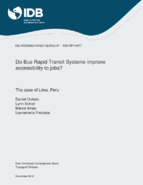Do Bus Rapid Transit Systems Improve Accessibility to Jobs?: The Case of Lima, Peru
Date
Dec 2018
Investments in public transit infrastructure in Latin America and the Caribbean often aim to reduce spatial and social inequalities by improving accessibility to jobs and other opportunities. The Metropolitano, Lima’s BRT project at inception, had, as one of its central goals, to connect low income populations living in the peripheries to jobs in the city center. We examine the contribution of Lima’s Bus Rapid Transit (BRT) system to accessibility to employment in the city, particularly for low-income public transit users. We build on secondary datasets of employment, household socio-demographics and Origin-Destination surveys before and after the BRT began operations to assess its effects on potential accessibility to employment. Findings suggest that the BRT line reduced travel times to reach jobs, in comparison with traditional public transport in the city, amongst populations living within walking distance of the system. However, we also find that the coverage of the BRT is minimal in areas with high concentrations of poor and extreme poor populations, limiting the equitability of the accessibility improvements. We present a reflection on the distributional effects of BRT infrastructure and services, discussing policy avenues that can improve the prospects for BRT system investments to include the poor in their mobility benefits.




